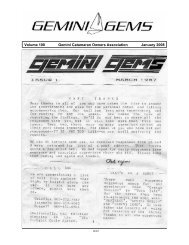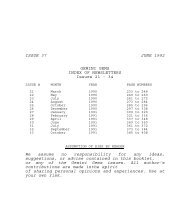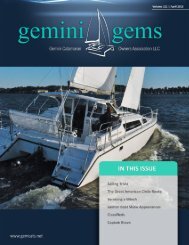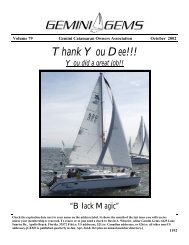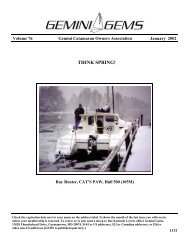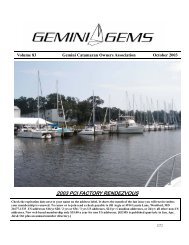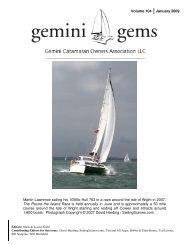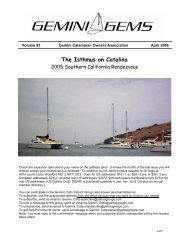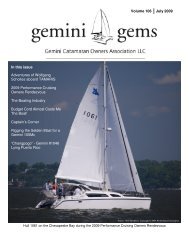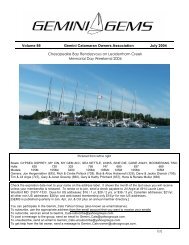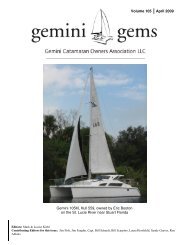Gemini Owners Manual.pub - Gemini Gems
Gemini Owners Manual.pub - Gemini Gems
Gemini Owners Manual.pub - Gemini Gems
Create successful ePaper yourself
Turn your PDF publications into a flip-book with our unique Google optimized e-Paper software.
<strong>Gemini</strong> 105Mc Owner’s <strong>Manual</strong><br />
shrouds should move about 2".<br />
The checkstays do not need to be tight at all because<br />
they only serve to stop the mast from pumping<br />
when beating to windward. For racing, the clevis pin<br />
securing the turnbuckle to the pad eye can be replaced<br />
with a quick release 3/8 pin, for down wind<br />
disconnection.<br />
The mast is normally set vertical. Moving the mast<br />
does not seem to affect the helm.<br />
With the <strong>Gemini</strong> 105Mc the mast is raised 1’, includes<br />
a 1’ crane on the top, and the boom is extended<br />
1’ compared to older <strong>Gemini</strong> models. (The<br />
older masts were 38’ off the deck; the 105Mc mast is<br />
39’ off the deck)<br />
Mast Rigging<br />
there is no means of feeding the lines without them<br />
crossing.<br />
The boat comes standard with lazy-jacks. On the<br />
underside of the boom are two padeyes at 5-foot<br />
increments. A 12-foot line goes between these padeyes<br />
either side of the boom and is attached to a<br />
line that goes to a pulley 5 foot below the upper<br />
spreader on the mast. These single lines go back<br />
down to cleats by the boom. With this configuration,<br />
the lazy-jacks can be tensioned by the cleat or<br />
removed when sailing.<br />
The forestay meets the mast at the 38-foot mark<br />
leaving a foot above it for the optional “roller<br />
screacher”, which is basically a roller-furling drifter.<br />
This is an excellent option for the cruiser that doesn’t<br />
want to bother with a spinnaker in light airs. The<br />
screacher option includes supporting hardware consisting<br />
of a mounted track that curves from one bow<br />
to the other across the bowsprit. The base of the<br />
sail can travel over the track and be brought to<br />
windward.<br />
The main sail has also changed with this 105Mc mast.<br />
The crane provides for a much larger mainsail and<br />
helps in obtaining maximum drive out of the top of<br />
the sail. With this crane we can have a large roach<br />
mainsail. However, so the sail doesn’t get caught up<br />
in between the backstays, there is a single backstay<br />
with a tensioner about 15’ up. The backstays only<br />
need to be tensioned during up wind work and should<br />
be slack at the dock.<br />
Boom<br />
The boom is 15ft. long and is secured to the mast at<br />
the gooseneck with a clevis pin. The boom has three<br />
pulleys at the stern end and three jam cleats at the<br />
underside of the boom at the gooseneck end.<br />
The starboard pulley and jam is for the first slab<br />
reef. The second pulley is for the out-haul. The third<br />
pulley is for the second reef. The sail that comes<br />
with <strong>Gemini</strong> has slides on the foot so that the end of<br />
the slab reefing line can be tied around the boom.<br />
The first slab reef is between the second and third<br />
slider from the end while the second slab reef is<br />
between the fourth and fifth slider from the end.<br />
The main sheet goes to a triple block shackled to the<br />
under side of the boom. On the mainsheet track on<br />
the combing is a slider with a triple block, becket<br />
and jammer. The main sheet runs to the triple block<br />
with the becket and jammer on the center pulley,<br />
Copyright © 2004 Performance Cruising Inc.<br />
23



